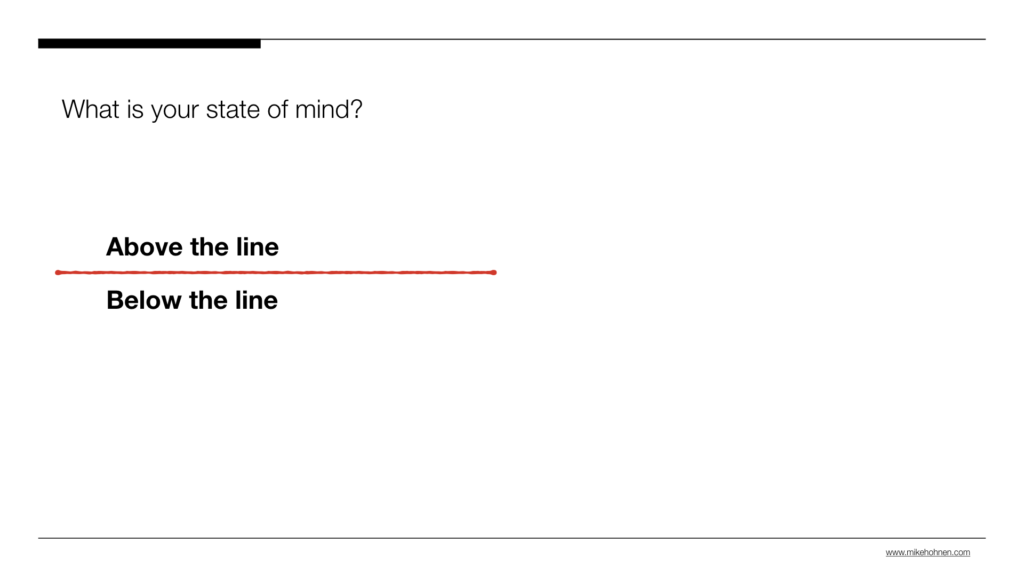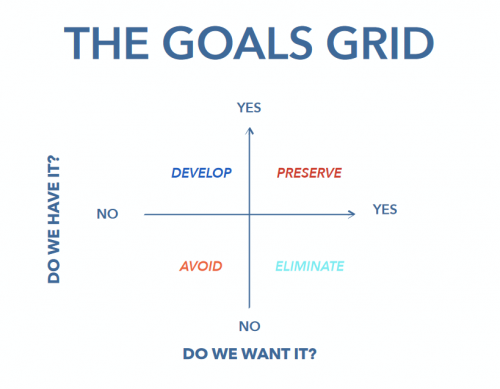This week I’d like to explore a mindset model that will help you raise your awareness of your own mindset and how that influences how you come across as a team leader.
In my previous blog post I started exploring the notion of leadership, leadership skills, what it takes to become a good team leader. Here we will dive deeper into what else it takes to develop followership as a team leader.
You get two versions video or full text. Pick whatever works best for you.
Here is a very simple mindset model that I use with leaders

The mindset model like all good models is simple and powerful. Integrate it into your tool box and you will be coming back to it again and again. I promise.
Above the line and below the line.
You can approach life and each situation from two points of view. Above the line or below the line. Depending on what you choose you will see yourself and others very differently.
When you operate from a state of mind that is above the line you are at ease, open and in a state of trust. On the other hand, if you are operating in a state that is below the line, you are essentially in a state of threat ( Fight, flight, freeze) and closed.
If you operate from a mindset that is above the line then it’s suddenly about everything that is not you. It’s all about the project, it’s about all of us, it’s how we develop this, how we solutions etc.
When you operate from a mindset that is below the line – in a state of treat – everything becomes about you.
When I’m above the line, I’m responsive. I think about the issue before I respond. I weigh my words a little bit more carefully and try to see the bigger picture.
In a below the line mindset I just react ( in defence) to what shows up.
So, we could summarise our mindset model like this: When I am above the line it’s about outcomes.When I’m below the line, I am essentially just defending my fragile little ego.”
You know what it feels like.
If you think about it you know the difference between being above the line and below. When you are above the line you are learning and growing, there is this sense of flow. Things are going smoothly. On the other hand, when you are below the line every step is struggle every interaction with others is a battle. Your interactions with other people is anywhere from mildly- to deeply toxic
The first step is self-awareness
Are you able to detect if you are above or below the line in any give situation – do you even notice? Do you notice that your body reacts in certain ways when you are below the line (we all react differently). What are signs you pick up when you feel even slightly threatened?
And once you notice, are you able to tell yourself the truth about what’s going on?
I am feeling slightly scared just now. This person is is challenging my know how how and it makes me angry.
The second step is to understand that being above or below the line is largely choice you have made – it is not something some one else has imposed on you.
That also means that if you feel like it, you can chose a different state of mind:
- shift from being closed to open
- shift from being defensive to being curious
- stop wanting to be right and wanting to learn instead
- stop being reactive and start being responsive
- end the drama and start creating something worthwhile
It your choice
But you can’t make that call if you are not even aware what is happening. If you don’t notice, if you are on zombie autopilot rushing through your todo list, just trying to return all the balls that are coming at you, back over the net trying to drop as few as possible, then there is not much awareness.
That’s a catastrophe. It’s really a catastrophe.
So, we’re going to be exploring this mindset model a bit further in my future blog posts
What does it take to cultivate more awareness? How do I consciously make these important shifts in my mindset – how can I change my state of mind?
What actually goes on below the line? Because I’ve given you a few hints but to be honest it’s quite a swamp down there. I mean drama triangles galore, and all sorts of other nonsense that you need to be able to identify and flag for yourself so that you can decide on an appropriate response.
We will also explore when is it OK to be below the line – because sometimes it is . You are not a robot. The only thing that is not OK is to not to be aware that you are below the line.
A final thought for you
So until next time here is a final though for you:
When you now think about being a teamleader – how much followership do you think you can generate from a mindset that is operating from below the line?
What happens if most of us during the day are all operating below the line in our organisations? What kind of a company culture do you think that creates?
It’s gets toxic, really toxic.
So, your assignment for the week is to start to notice. Just ask yourself a few times during the day ( set a reminder on your phone very 90 minutes) Where am I just now: Above or below the line?
If you would like to dive deeper into this subject I highly recommend : “Unlocking Leadership Mindtraps: How to Thrive in Complexity” by Jennifer Carvey Gerber







